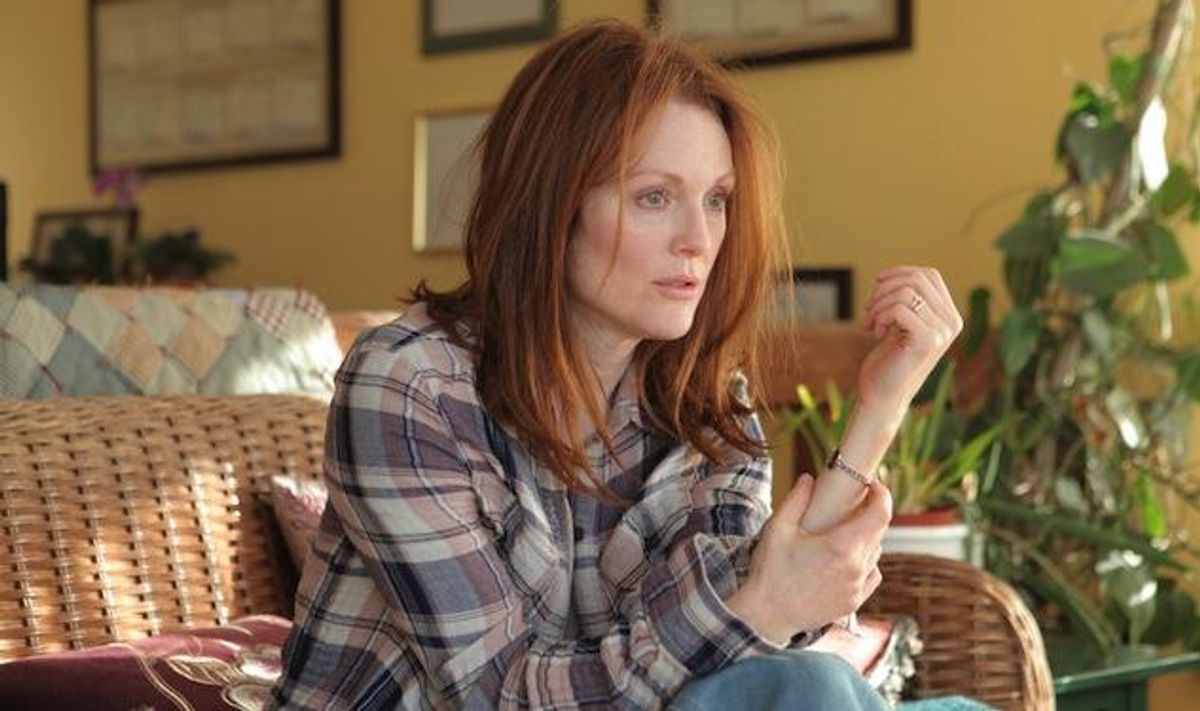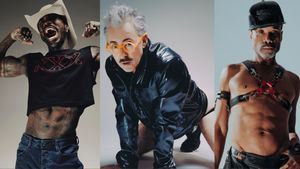
CONTACTStaffCAREER OPPORTUNITIESADVERTISE WITH USPRIVACY POLICYPRIVACY PREFERENCESTERMS OF USELEGAL NOTICE
© 2025 Pride Publishing Inc.
All Rights reserved
All Rights reserved
Scroll To Top
By continuing to use our site, you agree to our Private Policy and Terms of Use.
Some of the best movies by the best gay filmmakers are not about gay people. Think of the legends: Cocteau, Visconti, Almodovar elevated world cinema by extending their sensibilities to address the essence of the human condition as in Orpheus, Bellissima, Senso, White Nights; often by concentrating on universal experiences or a female lead character whose actions and emotions illuminate all relationships as in Women on the Verge of a Nervous Breakdown. That's the model Richard Glatzer and Wash Westmoreland follow in Still Alice.
Julianne Moore plays linguistics professor Alice Howland, a 50-year-old married mother of three, who is diagnosed with Early-Onset Alzheimers Disease. How she suffers the loss of her thinking ("I am defined by my intellect, articulation, language") makes for a story of identifiable sorrow and tenderness. Glatzer and Westmoreland, partners who live together and have made collaborative films since 1994, think and feel outside the gay ghetto. Westmoreland, whose filmmaking apprenticeship includes several porn features, expands their repertoire.
Still Alice's non-frivolous subject has personal significance for the duo (Glatzer was diagnosed with ALS in 2011) but the film is notable for the continually broadened scope of their filmmaking (beginning in 2006 with Quinceanera which observed a teenage Latina's coming of age). Awareness of the larger world is also part of Glatzer and Westmoreland's humanity, their gay humanity, their artistry.
The essential subject matter of art does not change for gay artists. Alice's interactions with husband John (Alec Baldwin), son Tom (Hunter Parrish) and daughters Anna (Kate Bosworth) and Lydia (Kristen Stewart) have the requisite--and recognizable--tonal differences to make their varied personalities credible. Some scenes recall the familial insight of Thomas Bezucha's The Family Stone, another outside-the-gay-ghetto touchstone.
In Still Alice's best scenes, Glatzer and Westmoreland convey the value we place on our human functions and the complexity of family tensions. They casually and pointedly detail Alice's life habits: teaching, cooking, cleaning, speaking--everyday rituals that foreground and introduce mortality.
Westmoreland and Glatzer engage Alice's dilemma by showing what gay artists have learned from the AIDS crisis about humanity and mortality--from porn to profundity. The AIDS experience has taught the world compassion. That lesson is felt, despite the film's stylistic ordinariness, in Alice's conflicts with rebellious Lydia whose struggling acting career mirrors Alice's clinical struggle with self-expression. Moore and Stewart have complementary acting rhythms with Stewart showing intensely beautiful anger and remorse; she channels it into Lydia's performance of a scene from Chekhov's Three Sisters and her own recitation of a speech from Angels in America, Part II (Perestroika).
Playwright Tony Kushner wrote Angels in America as an attempt to exceed party politics and sexual politics through visionary poetry ("souls were rising, floating up like sky divers in reverse"). He implied that spirituality transcends sexuality and his effort is affirmed when Alice fumbles to describe the play's scope but says "scape." It's a good gaffe because the landscape of gay filmmaking needs precisely the expansion of storytelling territory as Glatzer and Westmoreland demonstrate. That's how Still Alice differs from gay filmmaker Todd Haynes' repugnant Safe (1994), in which Moore also played a heterosexual woman plagued by illness.
Haynes' inability to empathize except with pathological conditions is an artistic disability. It is the opposite of what Cocteau, Visconti and Almodovar have taught; opposite the broad humanity gay director Patrice Chereau showed in Son Frere, which transferred AIDS crisis to a wider experience; opposite Robert Altman's great leap forward into female and gay consciousness in Come Back to the 5 & Dime, Jimmy Dean, Jimmy Dean.
Moore's Alice, struggling with "the art of losing," isn't a high camp virago like a drag version of Bette Davis in Dark Victory or Susan Hayward in Stolen Hours; neither is she a non-camp drip like her role in Haynes' pseudo soap-opera Far From Heaven. Dealing with non-gay experience so sensitively, Glatzer and Westmoreland consider our spirituality. Still Alice awakens our human responses.
Still Alice opens for a one-week awards qualifying run in New York City and Los Angeles on Dec. 5. Watch the trailer below:
From our Sponsors
Most Popular
41 male celebs who did full frontal scenes
September 16 2024 2:02 PM
39 LGBTQ+ celebs you can follow on OnlyFans
November 19 2024 9:39 AM
33 actors who showed bare ass in movies & TV shows
September 17 2024 5:43 PM
26 LGBTQ+ reality dating shows & where to watch them
December 10 2024 12:38 PM
21 times male celebrities had to come out as straight
November 19 2024 3:33 PM
17 queens who quit or retired from drag after 'RuPaul's Drag Race'
November 30 2024 12:26 AM
52 steamy celebrity Calvin Klein ads we'll always be thirsty for
August 27 2024 1:08 PM
15 things only bottoms understand
October 08 2024 5:18 PM
A gay adult film star's complete guide to bottoming
September 16 2024 8:50 AM
15 gay celebrity couples who make us believe in love
October 03 2024 5:43 PM
Latest Stories
A 2025 Guide to LGBTQ+ Spring TV
January 18 2025 12:53 PM
Trans comedians have advice for Dave Chappelle on SNL
January 18 2025 12:16 PM
What Alan Wore: 'The Traitors' references Easter Island
January 17 2025 8:06 PM
The Village People are now teaming up with Donald Trump—and here's why
January 17 2025 7:03 PM
'I Saw the TV Glow,' 'The Substance' lead LGBTQ+ critics' nods
January 17 2025 6:35 PM
Bob the Drag Queen reacts to 'Traitors' betrayal
January 17 2025 5:51 PM
Want to save LGBTQ+ lives? Take a 5-minute Narcan training
January 17 2025 3:00 PM
Boxers NYC's 2025 calendar serves bulging bartenders in the buff
January 17 2025 2:13 PM
Nearly 3,000 LGBTQ+ advocates to join Tre'vell Anderson at Creating Change in Las Vegas
January 17 2025 12:50 PM
Kara Swisher says Mark Zuckerberg is a 'small little creature with a shriveled soul'
January 17 2025 11:21 AM
WeHo art collector says he lost Warhols, Harings in L.A. fires
January 17 2025 10:56 AM
The Traitors: Boston Rob's drag witch hunt of Bob may backfire
January 16 2025 9:11 PM
Open wide for these 69 sizzling Winter Party Festival 2024 pics
January 16 2025 6:30 PM
Anyma's epic Sphere residency and what it means for EDM
January 16 2025 6:05 PM
Trump's 2025 inauguration: Here's the full list of performers
January 16 2025 5:43 PM
Omar Apollo calls out 'homophobes' upset for posting 'Queer' nude scene
January 16 2025 5:07 PM



















































































Beware of the Straightors: 'The Traitors' bros vs. the women and gays